- 웹진에 실린 글의 내용은 (재)예술경영지원센터의 의견과 다를 수 있습니다.
TEL 02-708-2293 FAX 02-708-2209 E-mail : weekly@gokams.or.kr
.jpg)
Art Beyond Art: Notes from Seoul 2022
미술시장의 현재와 미래 ② 글: Sebastian Cichocki_Chief Curator of Museum of Modern Art in Warsaw
글: Sebastian Cichocki_Chief Curator of Museum of Modern Art in Warsaw
 예술경영 485호_2022.9.29.
예술경영 485호_2022.9.29.
My visit to South Korea in the summer of 2022 was my first intercontinental trip after more than two years’ hiatus caused by restrictions during the COVID-19 pandemic. This trip was related to a new challenge in my professional life: the position of the curator of EVA International – Biennial of Contemporary Art in Ireland. I am currently working on a list of artists from around the world who will be invited to participate in the exhibition. Due to the limited time to prepare the biennial, less than twelve months, I decided to limit my travels to only a few countries where the art scene is particularly close to me. South Korea was my first choice. My task was primarily to update my knowledge about art in Korea, have meetings in art studios and museums, as well as participate in a programme of exhibitions and lectures of extraordinary intensity during the Frieze Seoul and KIAF fairs.
The task related to EVA, the Irish art biennial, is difficult because in my curatorial work (based both on my experiences at the Museum of Modern Art in Warsaw and with independent projects), I often look for artists who do not produce classical works of art. The artists that interest me the most initiate various processes, most often long-term ones, engage politically and believe in the social function of art. At the same time, they cross the boundaries of disciplines, also dealing with music, performative activities, and the creation of archives. This may mean that an exhibition is not always the most appropriate medium to present their practice, and that their work is not easily incorporated into the framework of a museum. In my curatorial work I have often referred to the texts of Jerzy Ludwiński, a Polish theorist, who in the 1970s foresaw the need to prepare for a completely new type of art that would develop in various “ecosystems”, often far away from art institutions, e.g. in activism, agriculture, or science. He called this specific activity “post-art”. Jerzy Ludwiński’s texts became my link to Korea in a surprising way. In 2018, during the Gwangju Biennial, I conducted a workshop on Ludwiński’s theory for young curator. And his key text, “Sztuka w epoce postartystycznej” (“Art in the Post-Artistic Era”) (1971), was translated into Korean. At the same time, a Korean translation of my book “S.Z.T.U.K.A.” (“ART”) was published, which was designed to introduce children to fifty select figures of 20th and 21st century art, especially those related to conceptualism and land art. My fascination with Korean art grew with each visit. I discovered new institutions and people characterized by unconventional thinking about the role of art in times of political polarisation and the climate crisis. This intense relationship with Korea was impaired by the Covid-19 epidemic.
Despite the obstacles in travelling, I managed to cooperate with others, such as with the activist and artist Hwayong Kim, in joining Warsaw and Seoul in the common cause of the role of art in the fight for women’s rights. In Warsaw, I also presented Kim Beom's works in-between the two lockdown periods. My return to Korea as part of the KAMS programme was an opportunity to verify my ideas about the current state of local art in Korea, to renew contacts, but above all to select artists for next year's biennial in Ireland. My last visit to Seoul, during the art fairs, was shocking in its way. It was a deep immersion into a place that had undergone tremendous changes over the previous two years. It seems that after the pandemic, the art community (both public and market-related) has been doubling and tripling its efforts to make up for lost time, significantly increasing the intensity and scale of its activities.
The Korean Arts Management Service programme allowed me, in its first carefully prepared reception, to return to the canon of contemporary Korean art. I especially remember a visit to the country studio of the legendary painter, Suh Yongsun. In a complex of spectacular buildings by a stream, there were works by the artist from several decades. They included the oft repeated pine motif characteristic of Suh Yongsun, scenes from city life, including those seen during his trips to Europe and the United States, as well as completely new works created after several months' stay on Jeju Island. These new paintings are delightful. I extracted them from under piles of other works, arranging them in series, putting them together in various combinations - imagining the process of working on the exhibition. One painting in particular, showing women extracting salt using traditional methods, stuck in my memory - it is a perfectly unruly, rugged picture, but also full of life.
At the other extreme there is the work of Meekyoung Shin, whose studio we visited with the KAMS team. I interpret her soap works as a critique of the canons of art, its loftiness and elitism. Copies of ancient vases or Greek and Roman sculptures with the use of such an unstable, decaying material as soap, are shockingly visceral. We visited the studio, which is located in a huge hall amongst expanding residential and business complexes. It resembled a production line, where the artist had gathered hundreds of ready-made works, packed in wooden boxes. The smell of soap pierced the nostrils, around there were works that the artist had previously placed in city restrooms - they were used to wash hands. In times of the pandemic, fear of the virus and the need for a sterile environment, this work takes on new meanings. We also see sculptures that were displayed outside, exposed to the mercy of weather conditions. These works have been distorted in a ghastly manner; they are deformed, often in a way resembling fanciful torture. Instead of durable marble and bronze, we are dealing with delicate, easily disintegrating forms. I also perceive these works as a bitter critique of the relations between East and West: the colonial past, the exploitation of resources, people and ideas.
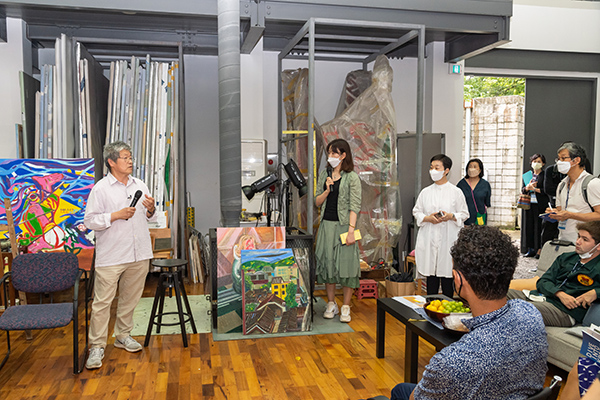
Suh Yongsun
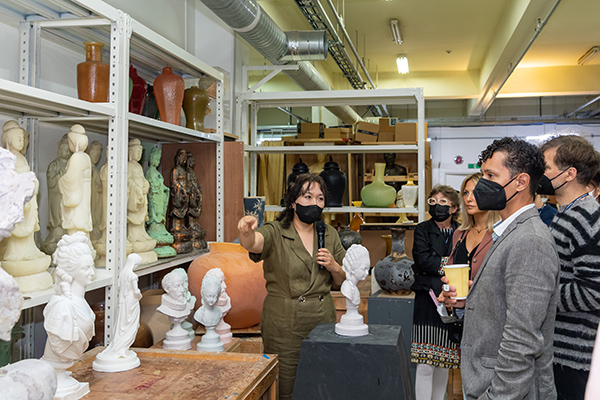
Shin Meekyoung
My visit to Korea also involved improvised visits, based on tips and recommendations from people such as Binna Choi, a South Korean curator, director of the Casco Art Instiut in Utrecht (the Netherlands). This, for a person unfamiliar with the city, led to a lot of challenging wandering around and searching for art studios scattered all over Seoul. One of my most vivid memories from my stay in Seoul last summer was a visit to the studio of the ikkibawiKrrr collective. Situated on a steep mountain amidst vegetable crops and countryside, the house offers a spectacular view of the city. This group, previously operating under the name mixrice, is the embodiment of “post-art”, as the aforementioned Jerzy Ludwiński would have put it. Their projects are so “camouflaged” in everyday life - cooking, farming, education, spending time together, caring for relationships with other people and nature - that it is almost impossible (or simply irrelevant) to clearly label them in terms of art, social activities or activism. They are a bit of all of this, proposing to go beyond the realm of art, while at the same time drawing abundantly from its tools, methods and sensitivity. The latest works by ikkibawiKrrr were presented this summer at Documenta in Kassel, one of the largest and most prestigious exhibitions of contemporary art in the world. The exhibition included the film “Seaweed Story” from Jeju Island, in which a choir of seaweed gatherers was involved. It is one of the most moving and visually seductive works of art that I have seen this year. The ikkibawiKrrr collective has gained proficiency in moving between activism, working for local communities and creating sophisticated visual works that resonate in the context of a museum exhibition. I believe that the meeting with ikkibawiKrrr was one of those events that set the tone and modified my thinking about the direction of the Biennial of Contemporary Art in Ireland. This exhibition will open in the summer of 2023, and it will definitely include art in the spirit of collective work, including pieces pastorally orientated toward the natural environment and the development of neighbourly relations.
My idea of Korean art is somewhat different from the carefully nurtured image of practice based on new technologies and related to issues such as posthumanism, transhumanism or deep species adaptation in the Anthropocene epoch. It is an image that European audiences derive from, for example, visits to the Venice Art Biennial and exhibitions at the Korean National Pavilion. Of course, this is largely a true image - during the KAMS programme, I met such recognized artists as the duo Moon Kyungwon & Jeon Joonho, working in the field of speculative science, art and architecture, and the author of fantastic films and animations, Ayoung Kim. At the same time, many of the artists with whom I have established relations with create art less related to technological advances and social media. Their art is closer to nature, political activism, current discussions on degrowth, loss of biodiversity or the mundane issues of professional rights. During this year’s stay in Seoul, for example, I had the opportunity to visit the studio and spend more time talking to film creator Jeamin Cha. Her mesmerizing works require the viewers’ focus and time. By surrendering to their slow rhythm, we enter a complex world built on the basis of a long process of searching and experimenting, a process sometimes lasting several years. Jeamin Cha is an artist who focuses on the issues of care, health and compassion, offering an insight into the world of people facing the limitations of the body and mind. Her art is a manifesto of care - sensitive and demanding.
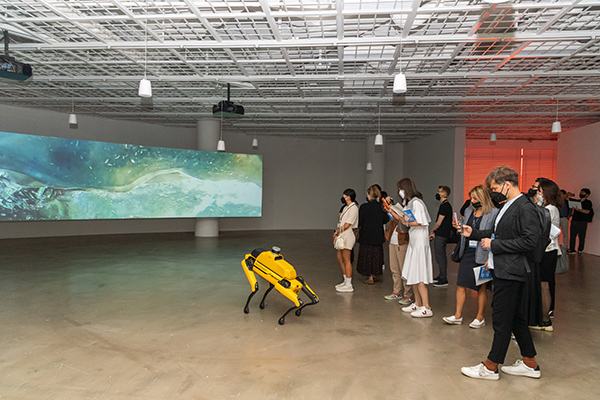
Moon Kyungwon & Jeon Joonho
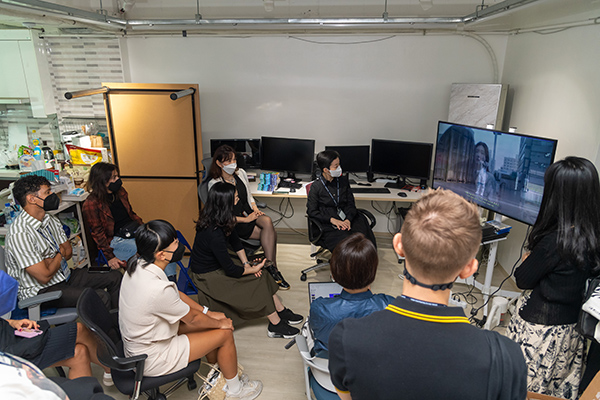
Kim Ayoung
The domain of Korean art has long been orientated toward the possibility to work in collectives and act for the common good. Many times in conversations with artists and curators during my trip, the subject of the great heritage of the Okin Collective and their criticism of the processes of gentrification, environmental degradation and uncontrolled urban changes in Seoul returned. In Europe, thanks to their participation in the Istanbul Biennial, the Flying City collective have become known, dealing also with the issues of architecture, public space and the side effects of the rapid development of cities in Korea. This year, I drew attention to several new art collectives, such as a group of female artists interested in the idea of “social fermentation”, participating in this year's Busan Biennial, and operating under the name The Rice Brewing Sisters Club.
The culmination of my stay in Seoul was a visit to Kim Beom, who for me is one of the most important contemporary conceptual artists. He is a person endowed with remarkable imagination, insight and humour. Kim Beom’s twelve-hour film, which records lectures on Jung Jiyong’s poetry for a stone lying on a table, is in my opinion one of the key works of contemporary Korean art. I presented this film at the exhibition “Penumbra Age. Art in times of planetary change” at the Museum of Modern Art in Warsaw. It's hard to imagine a work of art that better captures the idea of “deep time”. Kim Beom was also one of the authors invited to be part of a book we released during the lockdown in 2021. During this year’s stay in Korea, I realized how important this artist's work is for the younger generation. There is an English term “artists’ artist” - an artist who is particularly respected and inspires other artists and theorists, while not necessarily being recognized by the general public. I think this term fits Kim Beom, whose art is muted, does not seek publicity, and uses modest means. However, this work strongly resonates with current discussions on the relationship of man with nature, our planet, and spirituality.
The biennial in Ireland, on which I am currently working, will definitely involve Korean artists. The list of participants should be almost complete and will be announced by the end of the year. My intensive journey with KAMS, full of unforeseen events and discoveries, has certainly had a great influence on my curatorial decisions. I hope that my ties to the Korean scene will continue to grow, leading to a more pronounced presence of this unique art scene, including lesser known artists and collectives, at exhibitions in other parts of the world.
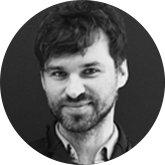
Sebastian Cichocki is Chief Curator and Head of Research at the Museum of Modern Art in Warsaw. He has twice curated the Polish Pavilion at the Venice Biennale and has been appointed a curator of EVA International - Biennial of Contemporary Art in Ireland.